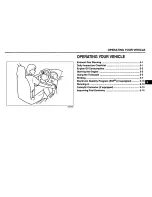
55
54
WARNING
Everyone in your vehicle needs to be buckled up at all times–babies and children,
too. Every state in the United States and all Canadian provinces require that small
children ride in proper restraint systems. This is the law, and you can be prosecuted
for ignoring it. There are different sizes and types of restraints for children from
newborn size to the child almost large enough for an adult safety belt. Always check
the child seat owner’s manual to ensure you have the correct seat for your child. Use
the restraint that is correct for your child. In a collision, an unrestrained child, even
a tiny baby, can become a missile inside the vehicle. The force required to hold an
infant could become so great during an accident that you could not hold the child
no matter how strong you are. The child and others could be badly injured. Any child
riding in your vehicle should be in a proper restraint for the child’s size.
4. CHILD RESTRAINTS
INFANTS AND CHILD RESTRAINTS
Safety experts recommend that children ride rearward-facing in the vehicle until
they are at least one year old and weigh at least 20 lbs (9 kg). Two types of child
restraints can be used rearward-facing: infant carriers and “convertible” child seats.
The infant carrier is only used rearward-facing in the vehicle. It is recommended for children
who weigh up to about 20 lbs (9 kg). “Convertible” child seats often have a higher weight limit in
the rearward-facing direction than infant carriers do so they can be used rearward-facing by children
who weigh more than 20 lbs (9 kg) but are less than one year old. Both types of child restraints
are held in the vehicle by the lap/shoulder belt. This vehicle is equipped with a LATCH (Lower
Anchors and Tethers for CHildren) child restraint anchorage system on the passenger seat.
Fasten the child safety seat’s lower attachments to the vehicle’s lower anchors. Tighten and
adjust according to the instructions and check for a secure fit. If the child seat has an upper
tether, pull the tether strap over the seat and secure it to the tether anchor on the lower back
of the vehicle seat. Improper installation can lead to failure of an infant or child restraint. It
could become loose in a collision. The child could be badly injured or killed. Follow the child
seat manufacturer’s directions exactly when installing an infant or child restraint.
Turn the passenger airbag system off if you have a child or infant in the passenger seat; refer
to the airbag section.
Refer to the airbag section for important information regarding passenge airbags. If you have a child
or infant on the passenger seat, turn the passenger airbag off.
Summary of Contents for LiFe 2011
Page 1: ...owner s manual ...
















































